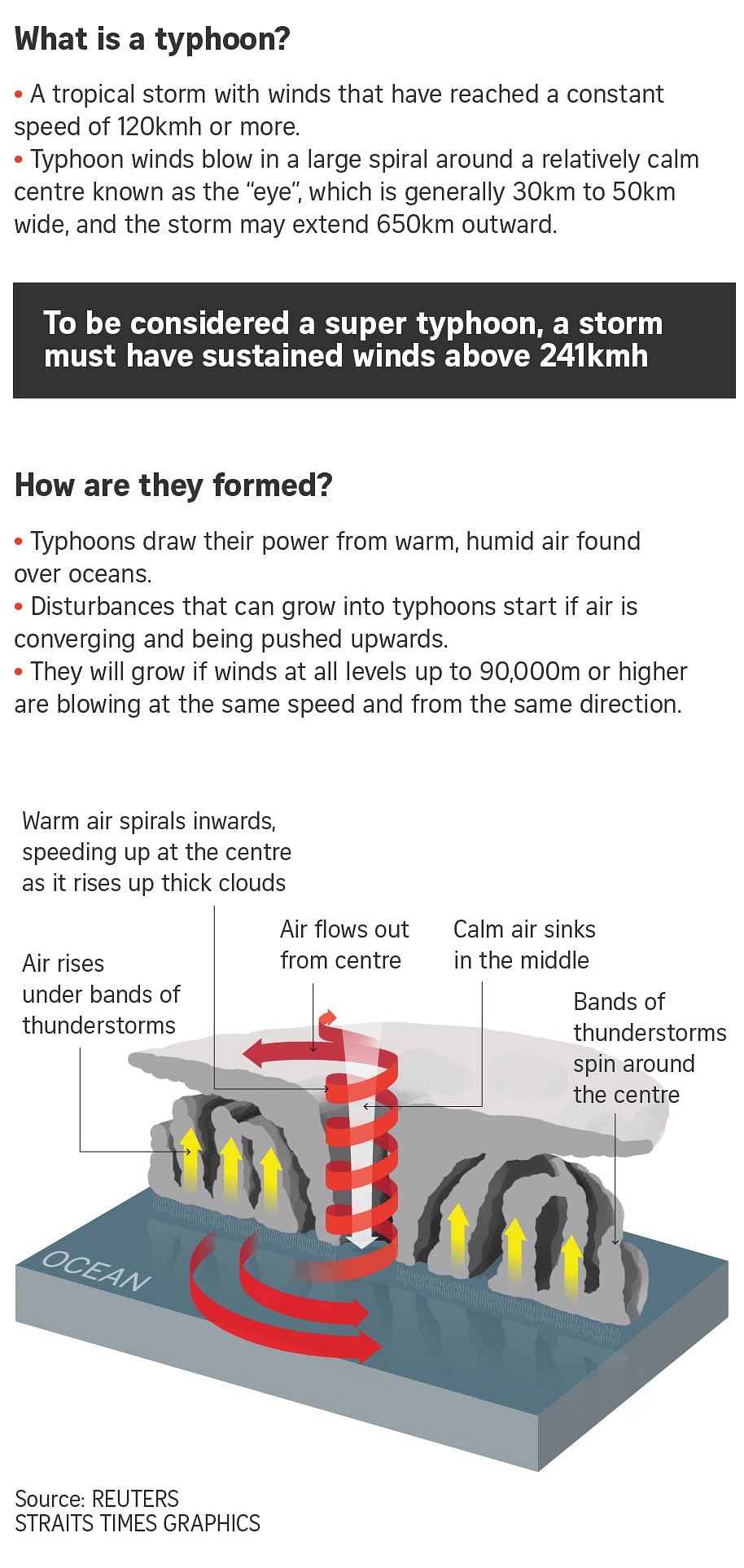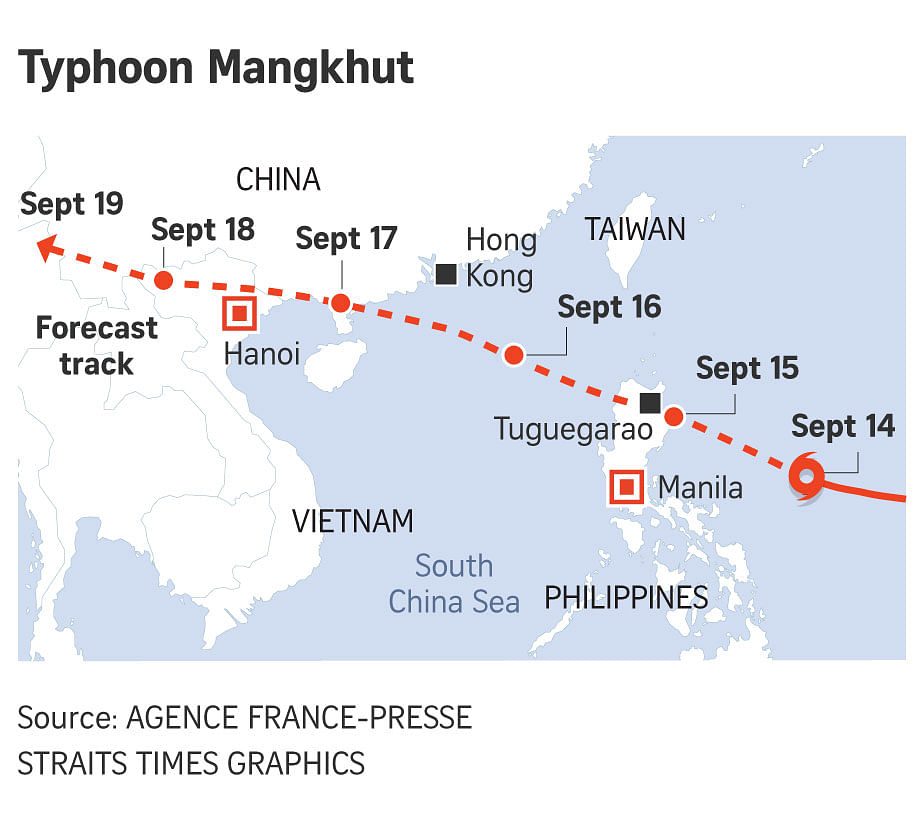All you need to know about Mangkhut and what makes it a super typhoon
Sign up now: Get insights on Asia's fast-moving developments

A weather forecaster points out the predicted tract of Typhoon Mangkhut in the town of Aparri, Cagayan province, Philippines, on Sept 14, 2018.
PHOTO: EPA-EFE
Chang Ai-Lien
Follow topic:
Super Typhoon Mangkhut is set to wreak havoc when it is expected to slam into the Philippines on Saturday (Sept 15). Professor Benjamin Horton, a principal investigator at Nanyang Technological University's Earth Observatory of Singapore, explains what is behind this destructive force:
What is a super typhoon and how is it formed?
Hurricanes, typhoons and tropical cyclones are all large rotating storms that form over tropical or subtropical waters. If the storms formed in the Atlantic or Eastern Pacific oceans, they are called hurricanes. Similar storms in the Indian Ocean and South Pacific are known as cyclones, and those formed in the Western Pacific are called typhoons.
These storms are classified according to their maximum sustained winds, with the most common being the Saffir-Simpson scale which was developed for hurricanes formed in the Atlantic ocean.
Hurricanes fall into one of five categories. Hurricanes classed as Category 3 or greater are called major hurricanes, while those that are Category 1 and 2 are known as non-major hurricanes.
Super typhoon Mangkhut would be considered a strong Category 5 storm in the Atlantic Ocean. Such big storms are deadly. Category 5 Hurricane Maria left 2,975 dead in Puerto Rico last year.

How intense is Mangkhut?
The Philippines is bracing for Mangkhut, the most powerful storm this year, with millions living in its path and fears that its rains could combine with monsoonal storms that could spark landslides and flash flooding. Mangkhut currently has sustained winds of 265kmh and gusts of up to 325kmh. It is forecast to make landfall on Saturday.
With a massive rain band 900km wide, combined with seasonal monsoon rains, the storm could bring "heavy to intense" rains that could set off landslides and flash floods.
Mangkhut is the 15th storm this year to batter the Philippines, which is hit by about 20 storms a year and is considered one of the world's most disaster-prone countries.
But Mangkhut is not the strongest typhoon to hit the Philippines. In 2013, Super Typhoon Haiyan left more than 7,300 people dead or missing and displaced more than five million in the central Philippines. At the time, it was the strongest hurricane, typhoon or tropical cyclone ever recorded anywhere on Earth - by wind speed - one-minute sustained winds were 314kmh.
On the other side of the planet, Hurricane Florence is barrelling towards the United States Atlantic coast with two more hurricanes following closely behind. Hurricane Florence's peak intensity had sustained winds of 220 kmh. It is now a Category 2 hurricane.

What kind of havoc is Mangkhut expected to wreak?
Super typhoons can cause major damage and loss of life due to the heavy rains, strong winds, and storm surge. Hurricanes are among the most important and devastating natural disasters. The two most common measures of hurricane impact are deaths and economic loss.
Death tolls from super typhoons or Category 4 or 5 hurricanes can be staggering - over 20,000 lives were lost in the 1780 Antilles hurricane, perhaps as many as 400,000 died as a result of 1970's Bohla tropical cyclone in Bangladesh, and more than 10,000 perished during 1998's Hurricane Mitch.
Will there be any impact here in Singapore?
No there will not - the hurricane is anticipated to track from the Philippines towards Hong Kong. Indeed, a typhoon is unlikely to strike Singapore. This is because typhoons usually form more than 10 deg north and south of the equator and move towards the poles and away from the equator.
Typhoon Vamei, which hit eastern Malaysia in 2001, is a rare example in recorded history of a typhoon that formed near the equator and made landfall in Johor. It caused millions of dollars of damage and killed five people.
This type of storm was previously thought to be impossible, and scientists at the Naval Postgraduate School in the United States concluded in their post-disaster report that it was caused by a perfect storm of factors, including the rare persistence of both a low pressure area and a cold surge in the region. They estimated that a typhoon like that one was likely to happen only once every 100 to 400 years.
But scientists have warned that although Singapore is not likely to be affected directly by typhoons, there are indirect costs. These include the closure of international finance institutions such as the Hong Kong stock exchange, potential damage to overseas investments from Singapore companies and the loss of crops from overseas suppliers.
Is climate change making the situation worse?
Attributing any hurricanes, typhoons or tropical cyclones to climate change is challenging because these events are by definition rare and therefore hard to evaluate reliably. For example, there have been just three Category 5 hurricanes in the past decade.
But these hurricanes aren't the only category of storm that cause significant damage. When Hurricane Harvey hit in August 2017 as a Category 4, it dropped 1.5m of rain over Houston, Texas, flooding the streets, leaving 93 dead and hundreds more having to be rescued by boat, causing millions of dollars of damage.
The intensity, frequency, and duration of North Atlantic hurricanes, as well as the frequency of the strongest hurricanes, have all increased since the early 1980s. A recent study has shown the number of slow-moving tropical cyclones, which would include those like Florence and Harvey, have become more common over the last 70 years. This is worrying because there is more time for rain to fall and the storm surge is more likely to coincide with high tide, and it increases the amount of time that structures are subjected to strong wind.
Nevertheless, the increase in storms can be attributed to human-induced climate change. The world's oceans continue to warm at a fast rate, which means hurricanes are more likely. Hurricanes draw their energy from deep below the ocean's surface - up to depths of 2,000m. The temperature at these depths is measured by Ocean Heat Content, a metric that has soared since 1970. Last year was the hottest on record.

